
anointing kings
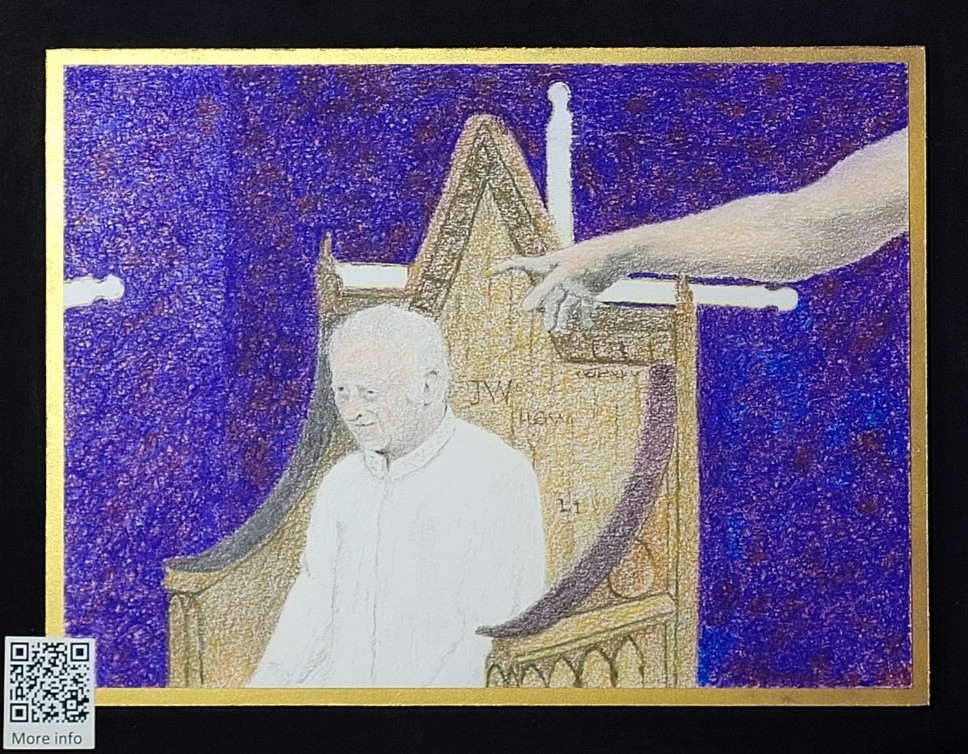
The most sacred moment of King Charles III’s coronation in Westminster Abbey took place just after he has signed a declaration of his intent for the church to secure the Protestant succession to the throne, and to uphold and maintain said enactments.
Everyone at the Abbey heaved a huge sigh of relief when the fountain pen did not leak over his fingers, and that someone had thoughtfully removed the ceremonial inkwells.
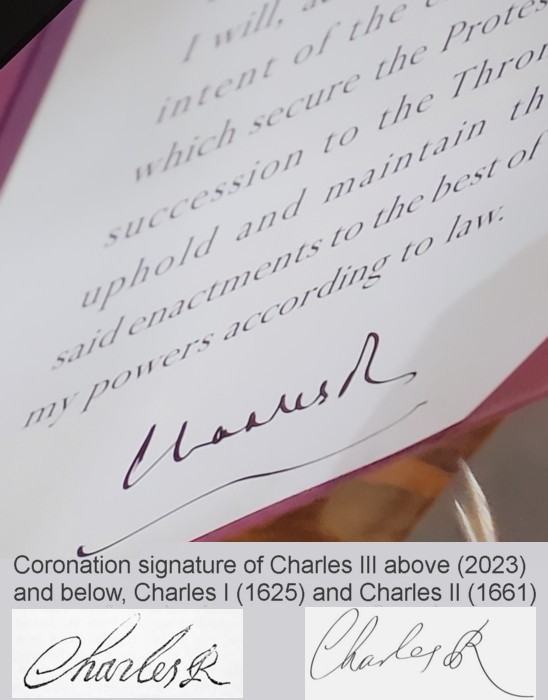
Purple exclusion screens for secret sacred moments are then arranged around the Coronation Chair that has the stone of Destiny incorporated on a shelf. At the same time Charles strips off his jewellery (except the ring on his little finger), and all his finery down to a ‘simple white robe’ that has some very elaborate yet subtle embroidery in fine gold thread on the collar.
Charles then goes behind the screens and sits in the coronation chair. Hidden from everyone in the Cathedral but the Archbishop of Canterbury and his Dean, he was anointed by God in a religious tradition that symbolises the sovereign’s divine right to the throne.
Justin Welby, the archbishop of Canterbury and top Anglican in England, anoints Charles on his hands, chest and head with special oil as he says, “So be you anointed, blessed and consecrated King over the Peoples, whom the Lord thy God hath given thee to rule and govern”.
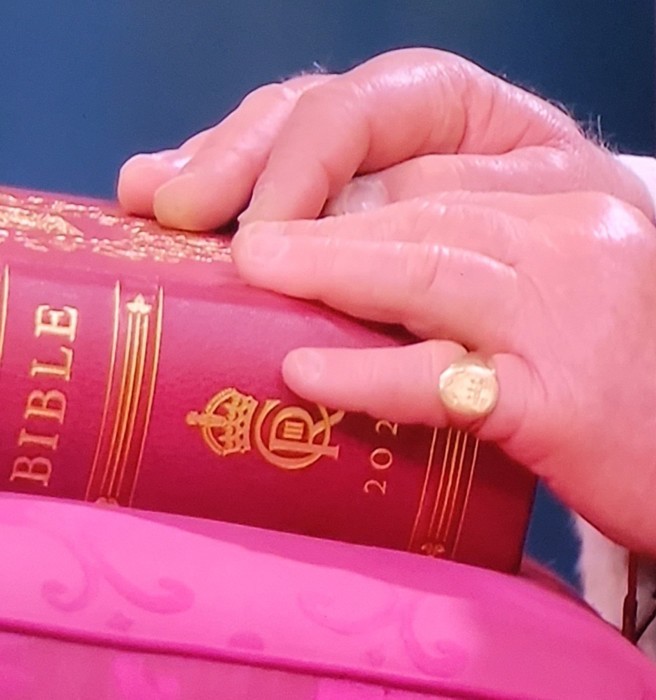
This Chrism oil was created from olives harvested from two groves on the Mount of Olives in Jerusalem, one at the Monastery of the Ascension and at the other at the Monastery of Mary Magdalene, The Grandmother of Charles, his Dad’s Mum Princess Alice of Greece, is buried at the Monastery of Mary Magdalene.
In a break with the centuries old tradition they left out ingredients from a musk deer, a civet cat and a sperm whale. It was made vegan, to highlight the sensitivity of the new king against animal cruelty and it is perfumed with rose, jasmine, cinnamon, amber, sesame, orange blossom, and neroli, (from the flowers of the bitter orange tree).
The Chrism oil that was used to anoint Charles and Camilla was blended and consecrated by the Patriarch of Jerusalem, His Beatitude Patriarch Theophilos III, at the Basilica of the Holy Sepulchre in Jerusalem.

The Archbishop of Jerusalem, The Most Reverend Hosum Naoum in Anglican pink, who oversees 28 parishes across five political regions, including Israel, Palestine, Jordan, Syria, and Lebanon, seen here with his allocated amount of the special oil that will accompany him to Westminster Abbey.
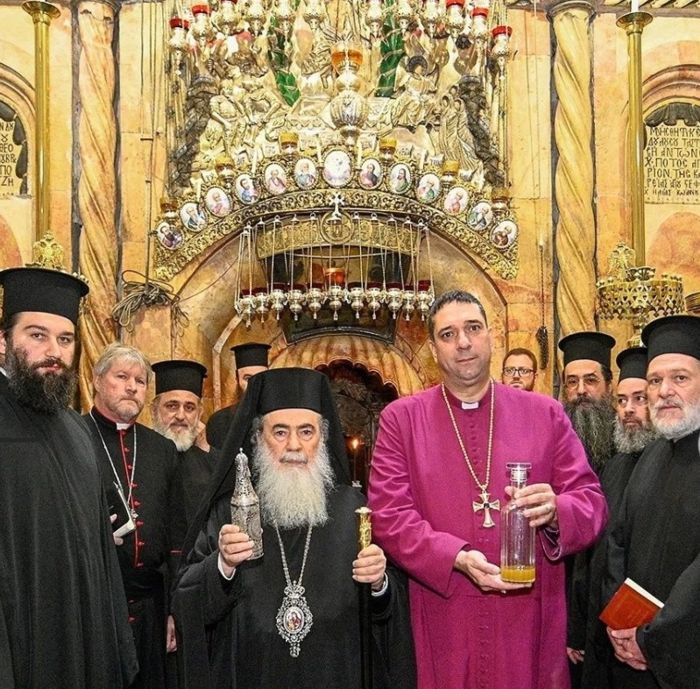
Once the special oil is in Westminster Abbey and transferred into the Golden Ampulla, The Most Reverend Hosam Elias Naoum then presents it to the Archbishop of Canterbury who enhances it with another blessing. The oil filled Golden Ampulla is then handed to the Dean of Westminster who is tasked with pouring a tiny amount of the Chrism oil into the twin bowls of the Christening Spoon. The Dean then presents the special spoon to the Archbishop of Canterbury who dips his fingers in the oil in the spoon and anoints the King on his hands, chest, and head. Queen Camilla is anointed later with more of the same oil.

The fat pigeon sized Gold Ampulla, (fancy name for a flask), that is meant to represent an eagle, has a head that screws off so that oil can be poured in, and a hole through its beak so that oil can be poured out. All the current royal gold regalia was made for the coronation of King Charles II in 1661. The original royal gold was melted down or sold during the twenty years England was a republic after King Charles I was found guilty of treason and had the top and bottom of his neck separated. The only golden paraphernalia from earlier than 1661 is the gold plated silver coronation spoon.
The silver-gilt Coronation spoon is the oldest piece in the regalia, and probably made for Henry II or Richard I in the 12th century. It was used to anoint King James 1 in 1603 and has featured at every coronation since. When they made all the new crowns and glittery bits for the coronation of Charles II the spoon was pimped with the addition of the 4 little pearls on its handle. The bowl of this spoon is divided into two sections for some reason nobody remembers, maybe so the the anointer can get a little oil on two fingers at once.
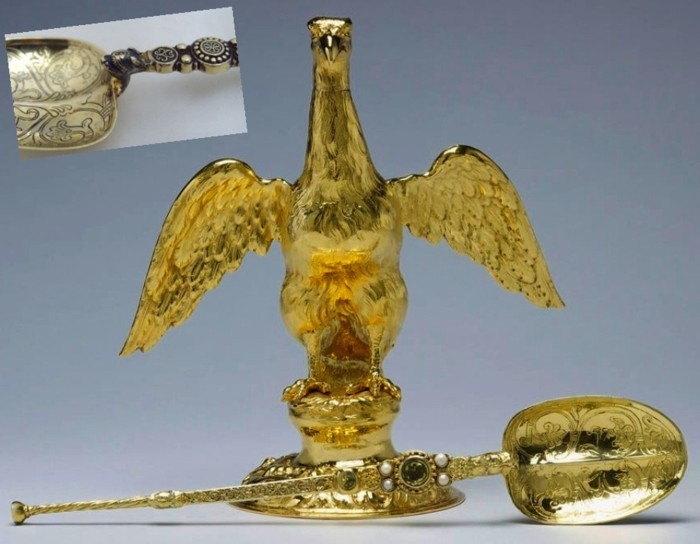
After Charles has been anointed with the Chrism oil the secret mens business is over and he comes forward and kneels for some words of encouragement from the leaders of Westminster Abby, before standing up so that the bald white men can clothe him.
No more white mink, now that he has been ‘anointed, blessed and consecrated King over the Peoples, whom the Lord thy God hath given thee to rule and govern’, he has to wear a cloak of spun gold.
Once suitably clothed he turns and returns to sit in the coronation chair. First he is handed a sword but he has to give that back, and in return the head wizard puts a heavy old crown on his head. The wizard mumbles something and then gives Charles one fancy oven glove. More mumbling and he is given a fancy stick to hold in the gloved hand and another fancy stick for the other hand, they don’t mind if this one gets a little Chrism on.
Then he is done and after they take back all the extra fancy bits it’s time for the bald white men to preform their shortened version of the secret mens business to anoint the Queen. Camilla gets a quick version of the oil by God, second hand crown, different magic wands and we’re good to go.
The clever people on twitter were quick and ‘@HappyToast’ had the new King online the very next day enjoying all of the new Kingyness.

For interested monarchists, Lambeth Palace has published the Liturgy, (what everyone read from their cue cards), for the Coronation Rite of His Majesty King Charles III at Westminster Abbey on 6th May, 2023. The theme of the Liturgy is “Called to Serve”. This reflects the decades of public service of The King and The Queen, and the commitment that Charles III made to serve God and the people. Full pdf of Liturgy from the day can be downloaded here
https://www.churchofengland.org/sites/default/files/2023-04/23-24132%20Coronation%20Liturgy.pdf
The minor guests had to be in place in the Abbey before the Royals arrived, and they did not arrive until Charles, with a lot of discrete but very animated gesturing, had the carriage backed up far enough that his fancy shoes would not touch uncarpeted footpath. As the crowns and orbs arrived one gentleman showed his displeasure at being stuck standing right on the central aisle, because his wife chose the wheelchair rather than the wheelie walker.
He stood with his hands in his pockets to express his disdain at all the pomp and he received a glorious side eye from the wife for not playing the part, as the 2.23 kilogram St Edwards Crown was walked past.
Full credit goes to the camera operator who kept his focus tightly on the glittery bits.
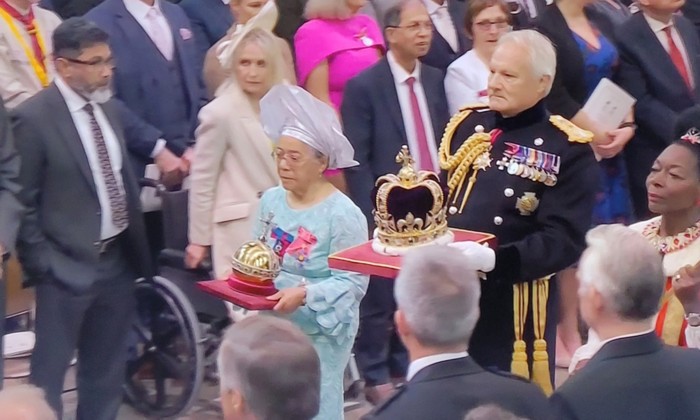
When scanned the QR code on the mat of the framed drawing will take the viewer to this web page